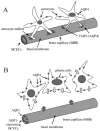Aquaporins and Brain Tumors
- PMID: 27367682
- PMCID: PMC4964405
- DOI: 10.3390/ijms17071029
Aquaporins and Brain Tumors
Abstract
Brain primary tumors are among the most diverse and complex human cancers, and they are normally classified on the basis of the cell-type and/or the grade of malignancy (the most malignant being glioblastoma multiforme (GBM), grade IV). Glioma cells are able to migrate throughout the brain and to stimulate angiogenesis, by inducing brain capillary endothelial cell proliferation. This in turn causes loss of tight junctions and fragility of the blood-brain barrier, which becomes leaky. As a consequence, the most serious clinical complication of glioblastoma is the vasogenic brain edema. Both glioma cell migration and edema have been correlated with modification of the expression/localization of different isoforms of aquaporins (AQPs), a family of water channels, some of which are also involved in the transport of other small molecules, such as glycerol and urea. In this review, we discuss relationships among expression/localization of AQPs and brain tumors/edema, also focusing on the possible role of these molecules as both diagnostic biomarkers of cancer progression, and therapeutic targets. Finally, we will discuss the possibility that AQPs, together with other cancer promoting factors, can be exchanged among brain cells via extracellular vesicles (EVs).
Keywords: aquaporins (AQPs); blood–brain barrier (BBB); brain tumors; extracellular vesicles (EVs); glioblastoma multiforme.
Figures


Similar articles
-
Overcoming the blood-brain tumor barrier for effective glioblastoma treatment.Drug Resist Updat. 2015 Mar;19:1-12. doi: 10.1016/j.drup.2015.02.002. Epub 2015 Mar 6. Drug Resist Updat. 2015. PMID: 25791797 Review.
-
Endothelial cell barrier impairment induced by glioblastomas and transforming growth factor beta2 involves matrix metalloproteinases and tight junction proteins.J Neuropathol Exp Neurol. 2008 May;67(5):435-48. doi: 10.1097/NEN.0b013e31816fd622. J Neuropathol Exp Neurol. 2008. PMID: 18431253
-
The disturbed blood-brain barrier in human glioblastoma.Mol Aspects Med. 2012 Oct-Dec;33(5-6):579-89. doi: 10.1016/j.mam.2012.02.003. Epub 2012 Feb 23. Mol Aspects Med. 2012. PMID: 22387049 Review.
-
Extracellular Vesicles in Glioma: From Diagnosis to Therapy.Bioessays. 2019 Jul;41(7):e1800245. doi: 10.1002/bies.201800245. Epub 2019 Jun 12. Bioessays. 2019. PMID: 31188499 Review.
-
Aquaporins as diagnostic and therapeutic targets in cancer: how far we are?J Transl Med. 2015 Mar 21;13:96. doi: 10.1186/s12967-015-0439-7. J Transl Med. 2015. PMID: 25886458 Free PMC article. Review.
Cited by
-
Updated Systematic Review on the Role of Brain Invasion in Intracranial Meningiomas: What, When, Why?Cancers (Basel). 2022 Aug 27;14(17):4163. doi: 10.3390/cancers14174163. Cancers (Basel). 2022. PMID: 36077700 Free PMC article. Review.
-
Involvement of Astrocytes in the Formation, Maintenance, and Function of the Blood-Brain Barrier.Cells. 2024 Jan 12;13(2):150. doi: 10.3390/cells13020150. Cells. 2024. PMID: 38247841 Free PMC article. Review.
-
Brain Mapping as Helpful Tool in Brain Glioma Surgical Treatment-Toward the "Perfect Surgery"?Brain Sci. 2018 Oct 26;8(11):192. doi: 10.3390/brainsci8110192. Brain Sci. 2018. PMID: 30373168 Free PMC article.
-
Recent Advances in Chinese Herbal Medicine for Cerebral Ischemic Reperfusion Injury.Front Pharmacol. 2022 Jan 17;12:688596. doi: 10.3389/fphar.2021.688596. eCollection 2021. Front Pharmacol. 2022. PMID: 35111041 Free PMC article. Review.
-
Efficient Radiomics-Based Classification of Multi-Parametric MR Images to Identify Volumetric Habitats and Signatures in Glioblastoma: A Machine Learning Approach.Cancers (Basel). 2022 Mar 14;14(6):1475. doi: 10.3390/cancers14061475. Cancers (Basel). 2022. PMID: 35326626 Free PMC article.
References
-
- Burton E.C., Lamborn K.R., Feuerstein B.G., Prados M., Scott J., Forsyth P., Passe S., Jenkins R.B., Aldape K.D. Genetic aberrations defined by comparative genomic hybridization distinguish long-term from typical survivors of glioblastoma. Cancer Res. 2002;62:6205–6210. - PubMed
Publication types
MeSH terms
Substances
LinkOut - more resources
Full Text Sources
Other Literature Sources
Medical
Research Materials

